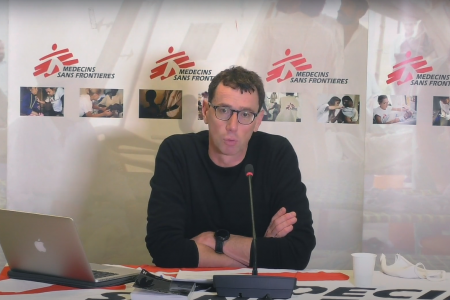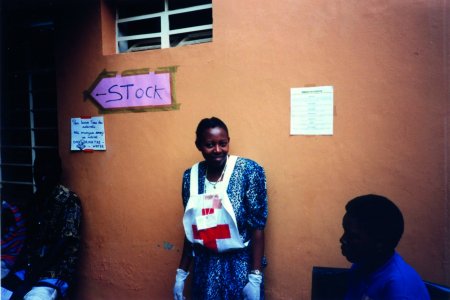The invention of impartiality: the history of a humanitarian principle, from a legal, strategic and algorithmic perspective
Joël Glasman
This article is a joint publication with Alternatives Humanitaires.
The principle of impartiality, which is often reduced to a principle of mathematical distribution, was originally coined by the International Committee of the Red Cross (ICRC), at that time on a quest for legitimacy. However, reducing impartiality to a resource distribution algorithm strengthens the overarching position held by non-territorial organisations. This is the theory put forward by the author in his latest book.
Impartiality in one of the least disputed humanitarian principles in the aid sectorMarion Pechayre, "Impartialité et pratiques du triage en milieu humanitaire. Le cas de Médecins Sans Frontières au Pakistan", Le Cahiers du Centre Georges Canguilhem, vol. 6, n°1, 2014, p. 125-142.. While the meaning and usages of other principles, such as neutrality and independence, are passionately debated, there is a broad consensus about the principle of “impartiality”. Indeed, not only the large humanitarian organisations – both secular and faith-based non-governmental organisations (NGOs), as well as the American and European aid agencies – all endorse the principle, but nation-states and private funding bodies even give it a special placeSee the signatories of the “Code of Conduct for the International Red Cross and Red Crescent Movement and NGOs in Disaster Relief” (Steering Committee of Humanitarian Response, 1994). For France: Ministère de l’Europe et des Affaires étrangères, Stratégie humanitaire de la République française, 2018-2022, Paris, 2018. .
However, the principle of impartiality has undergone a surprising transformation.
The generally accepted definition (from the 1994 Code of ConductIts exact title is the “Code of Conduct for the International Red Cross and Red Crescent Movement and non-governmental organizations (NGOs) in disaster relief.” Read and download the code: https://www.icrc.org/en/doc/assets/files/publications/icrc-002-1067.pdf (Editor’s note).) contains two sentences. The first sentence says, “Aid is given regardless of the race, creed or nationality of the recipients and without adverse distinction of any kind”. This is a non-discrimination clause. The second sentence says, “Aid priorities are calculated on the basis of need alone”. This is an aid proportionality clause. This is the most frequently quoted clause. The wording “on the basis of need alone” has become a mantra for some organisationsJames Darcy and Charles-Antoine Hofmann, “According to need? Needs assessment and decision-making in the humanitarian sector”, Humanitarian Policy Group Report, ODI, 2003. notably for the United Nations (UN) Office for the Coordination of Humanitarian Affairs (OCHA), which has reversed the order of the sentences: in this case, the non-discrimination clause becomes a simple consequence of the proportionality of needsResolution 46/182 of the 1991 United Nations General Assembly (A/RES/46/182), establishing an international humanitarian assistance coordination body (which became OCHA), reiterates the principle of impartiality. OCHA’s definition of impartiality is clearly inspired by the fundamental principles of the Red Cross: “Humanitarian action must be carried out on the basis of need alone [author’s emphasis], giving priority to the most urgent cases of distress and making no distinctions on the basis of nationality, race, gender, religious belief, class or political opinions” (OCHA on Message: Humanitarian Principles, 2011).
Humanitarian impartiality addresses a thorny problem of justice. How can we distinguish between legitimate and non-legitimate forms of discrimination? The first sentence responds by providing a non-exhaustive list of unfounded discrimination (race, creed, nationality and so forth), while the second sentence does not give any examples of legitimate discrimination. It simply lays down a general rule, that of proportionality: aid priorities are “determined on the basis of need alone”. The English language version of the Code of Conduct is more explicit than the French version, as it states that priorities must be calculated on the basis of need alone. Humanitarian justice therefore supposes that a calculation can be made, in other words, that human suffering can be mathematically objectified. This vision of humanitarian justice has little in common with that of the 19th century.
Inter : Humanitarian principles – a history
“Principles” are omnipresent in humanitarian discourse, but little interest is shown in their history. They are often regarded as being timeless: they are vaguely linked to the Red Cross, often without any further clarification, and it is almost always said that they are universal. Just like Athena being born from the forehead of her father, Zeus, humanitarian principles seem to have emerged “ready made” from Henri Dunant’s foreheadOr descending directly from space, as in the Harvard Humanitarian Academy’s futuristic illustration, https://hhi.harvard.edu/elearning/humanitarian-principles.
However, this magical vision of humanitarian principles is dangerous. It is based on realities that lack historical context and are therefore unarguable. In fact, these “universal” principles are the result of very real conflicts. They reflect interests that can be situated and dated.
When the Red Cross was founded in 1863–1864, its founders discussed its general policies, mentioning volunteer service, universality, free provision, philanthropy, neutrality, and impartiality. However, these were not “fundamental principles” as we would understand today. Furthermore, they were not even classed as “principles”, as by turn the terms “foundations”, “proposals” and “ideas” that would shape the Red Cross were used. They were at times philosophical principles and at times operating guidelines. A large number of ideas were debated for some time, such as “patriotism”, “compassion” and “obedience” (the subordination of the Red Cross committees to the military authorities), before being swiftly jettisoned. Other principles were invented, often competing with one another. There were twelve principles (in the 1880s), then around twenty (circa 1900), and subsequently six (1920)See Daniel Palmieri, the ICRC’s historian and archivist: « Les principes fondamentaux de la Croix-Rouge : une histoire politique », CICR, 6 juillet 2015, https://www.icrc.org/fr/document/les-principes-fondamentaux-de-la-croix-rouge-une-histoire-politique.
Impartiality was therefore one of the very first principles evoked by the founders of the Red Cross. It is generally thought to come from the 1864 Geneva Convention In 1864, five years after the Battle of Solferino, a diplomatic conference in Geneva brought together delegates from sixteen countries to sign the Geneva Convention for the Amelioration of the Condition of the Wounded in Armies in the Field., but that “impartiality” clause was very different from what we now understand by the term. Article 6 of the 1864 Convention said: “Wounded or sick combatants, to whatever nation they may belong, shall be collected and cared for.” This was a non-discrimination clause. It meant: look after your friends and your enemies. Nothing more. The principle of proportionality would only be added some seventy-five years later. In his law thesis published in 1955, Jean Pictet, the ICRC legal expert, rewrote “The Fundamental Principles of the Red CrossJean Pictet, « Les principes de la Croix-Rouge (II) », in Revue internationale de la Croix-Rouge, 37/441, 1955, p. 559-577 ; « Les principes de la Croix-Rouge (III) », in Revue internationale de la Croix-Rouge, 37/442, 1955, p. 633-640.". What was Pictet seeking to do by inventing proportionality? He was seeking to address ethical issues, naturally, but also to champion the interests of the ICRC itself in response to external attacks.
The Red Cross Movement then brought together two types of institutions: the ICRC on the one hand, based in Geneva, and the National Societies on the other hand (French Red Cross, German Red Cross, etc.), these latter being gathered in the “League of Red Cross Societies The League of Red Cross Societies then became the International Federation of Red Cross and Red Crescent Societies (IFRC).". But in 1946 the Governors of the League had published a series of “seventeen fundamental principles” to reorganise the Red Cross. This constituted an outright attack on the ICRC, considered until then as the guardian of humanitarian principles. However, since 1945 the ICRC had no longer been beyond reproach: its moral authority was being challenged by the national societies, and it was criticised for its ambiguous stance during World War II. The USSR accused it of not condemning the crimes committed by the Nazis, China of favouring Taiwan, East Germany of not denouncing the colonisation in Africa. Until then, the neutrality of Switzerland had justified the ICRC’s overarching position, but this was no longer the case. Confronted with the seventy National Societies, the ICRC was running the risk of being downgraded to the rank of one of many local partners. Indeed, the ICRC was so isolated that it even briefly considered leaving the Red Cross MovementSee Daniel Palmieri, « Les principes fondamentaux de la Croix-Rouge… », art. cit.. Pictet’s commentary was part of the ICRC’s counter-attack. A Ph.D. student supervised by the former president of the ICRC, Max Huber, Pictet emphasised the fundamental role played by the committee in the development of the humanitarian doctrine. He listed seven “fundamental principles” (humanity, equality, proportionality, impartiality, neutrality, independence and universality), which he distinguished from the “organic principles” of which there were ten (selflessness, free provision, voluntary service, etc.). This wording justified the ICRC’s special position within the Red Cross Movement and within the humanitarian sector as a whole. The Committee waged a moral and legal struggle for several years to ensure that Pictet’s principles were adopted by the entire movement – an aim not achieved until 1965.
Pictet actually “transformed” impartiality. How did he go about it? He firstly reworked the traditional clause by modernising it: “The Red Cross will act without favour or prejudice towards or against anyoneJean Pictet, « Les principes de la Croix-Rouge (III) », op. cit., p. 633.". This non-discrimination clause did not pose any particular concerns, as it was already enshrined in the 1864 Convention, and it was already well-established in the international law of the period. The clause appeared, albeit with different wording, at the start of the 1948 Universal Declaration of Human Rights, and in the 1949 Geneva Conventions prohibiting any form of discrimination “on the basis of sex, race, nationality, religion, political beliefs or other criteriaJean Pictet, « Les principes de la Croix-Rouge (II) », op. cit., p. 563.". However, Pictet added a second “positive” definition, explaining how aid should be shared out: “The help available shall be apportioned according to the relative importance of individual needs and in their order of urgency Jean Pictet, « Les principes de la Croix-Rouge (II) », op. cit., p. 568 (traduit par l’auteur). ".
This new principle, which he called “proportionality”, was also christened the “distribution rule”. In this instance, Pictet was on shaky ground. While non-discrimination was well-established in law, proportionality was more difficult to justify. The 1949 Geneva Conventions stated that for humanitarian organisations there were “permitted distinctions” but without specifying what they were. The conventions allowed distinctions to be made “on the grounds of suffering, distress or the inherent weakness of people being protected
Jean Pictet, « Les principes de la Croix-Rouge (II) », op. cit., p. 570.",but without elaborating on how to recognise this suffering. The Geneva Conventions simply stated that there could be a “priority in the order of treatmentArticle 12 of the first 1949 Convention establishes this point.".
Inter : The rationale of triage applied to humanitarian work
Military medicine provided Pictet with the decisive argument he needed to organise the order of treatment. Military medics treated “firstly those for whom a delay would be fatalJean Pictet, « Les principes de la Croix-Rouge (II) », op. cit., p. 570 (our translation). ". In this way, Pictet brought the technique of triage into humanitarian law. As medical historians have shown, this technique of sorting patients by order of priority dates back to the early 19th centuryGuillaume Lachenal, Céline Lefève et Vinh-Kim Nguyen, « Le triage en médecine, une routine d’exception », Les Cahiers du Centre Georges Canguilhem, vol. 6, n° 1, 2014, p. 1-25.. This method of rationally managing the assessment of the treatment needed by the injured became widespread during the First World War, during which it became a way of protecting military personnel, which involved ranking the injured into categoriesTriage became an indispensable technique for armies during the First World War. Injured soldiers were triaged before hospital trains departed: (1) immediate life-threatening emergency (respiratory and circulatory problems), (2) life-threatening emergency that could wait a few hours (open fractures, wounds in the upper areas of the limbs), (3) non-urgent cases, and (4) cases that were too complex or beyond help. . Triage therefore brought together two contradictory interests: lives needed to be saved, but the fighting force also needed to be protected. This was both a moral and a strategic question (Who can be transported? Who can be saved? Who can get better and get back into action?). It was not a case of firstly saving those who were suffering the most, but saving useful lives: a utilitarian “population-based” rationale on the one hand, based on the needs of the many, contradicted a “clinical” rationale on the other, focused on the needs of the individual. Pictet explained: “for the Red Cross, there are distinctions that are licit and even need to be taken regarding individuals: they are based on sufferingJean Pictet, « Les principes de la Croix-Rouge (II) », op. cit., p. 569 (our translation).".
By including triage in the terminology of humanitarian law, Pictet made a break with Dunant’s legacy without explicitly saying so. He shifted humanitarian aid into a new space and time framework. Dunant’s aid took place in a well-defined space. “Solferino” was a defined battlefield, a historical event with a start and an end, a limited disaster. For Pictet, the whole world had become a potential battlefield. Needs would always exceed resources. Triage was no longer about the needs of a conflict but applied to all humanitarian aid.
The now global nature of the issue neatly enabled Pictet to justify the overarching position of the ICRC. Granted, it was an organisation with a set location, with its buildings, offices and practical constraints. However, if considered from the perspective of “proportionality”, its humanitarian work could be presented as universal, and “more” universal, in any case, than all the other organisations. Pictet explained that the nation states prioritised aiding their “nationals”, while faith organisations prioritised those who “shared their faith”, professional bodies focused on “colleagues from the same profession”, and political parties favoured their “supporters Jean Pictet, « Les principes de la Croix-Rouge (II) », op. cit., p. 571 (our translation).". Each organisation placed a group of people before all the others. However, humanitarian solidarity prioritises strangers“Ultimately, it could almost be said, as if it were a law of physics, that aid delivered is inversely proportional to the square distance […] in a deprived continent, there will only be poor to help the poor, while in an inherently privileged region, the rich will help the rich.” (Jean Pictet, « Les principes de la Croix-Rouge (II) », op. cit., p. 572-573 [our translation]).!
Inter : At the roots of the ICRC’s overarching position
This is why the ICRC was becoming more legitimate than others at championing the humanitarian cause and defending its true principles: the ICRC could be truly impartial as it had no ties! Of course, this was not the case of the National Societies, which primarily assisted “people of their nationality”, as Pictet explained, “which was normal given the national nature of these institutions Jean Pictet, « Les principes de la Croix-Rouge (II) », op. cit., p. 571 (our translation).". Only the ICRC was truly capable of providing “aid solely commensurate with the scale of the distressIbid. (author’s emphasis). ".
In this way, Pictet created a structural equivalence between the ICRC’s position and the principle of proportionality: it is because it was not close to any group in particular that the ICRC could be fair towards all. This was a privilege that neither the League of the Red Cross, nor the States, and not even the other charitable organisations, could ever hope to achieve.
Pictet’s theory was a weapon of choice enabling the ICRC to regain a dominant position in the humanitarian sector. In 1965 in Vienna, Pictet’s principles were adopted, albeit with a few amendments, by the entire Red Cross Movement and by the governments of the States that had signed the Geneva ConventionsThe fundamental principles are: humanity, impartiality, neutrality, independence, voluntary service, unity and universality. While some principles have moved from being “organic” to “fundamental” (such as voluntary service), others have been classed in a single category (“equality” and “proportionality” are now sub-sections of “impartiality”). See Jean Pictet, « Les principes fondamentaux de la Croix-Rouge : commentaire », CICR, Genève, 1979.. The resolutions relating to the “fundamental principles” consequently became mandatory for the entire Red Cross MovementThe concept of impartiality is also strategic, as the Geneva Conventions grant rights and special responsibilities to “impartial humanitarian organisations” (Article 9 of the Geneva Convention). In his commentary of the Geneva Conventions, Pictet explains this concept of impartiality: “[the rescuer] is guided in his choice by the apparent gravity of the wounds, making no distinction between friends, allies and enemies. The ideal would be to be able to base the distribution of relief entirely on the actual needs” (Jean Pictet, Commentary on the Geneva Conventions of 12 August 1949, Vol 1: Geneva Convention for the Amelioration of the Wounded and Sick in Armed Forces in the Field, ICRC, Geneva, 1952, p. 109). Once the Cold War had ended in the early 1990s, nothing prevented the dissemination of the principles: the UN quoted them when founding its international coordination body (the future OCHA), NGOs adopted them by signing the Code of Conduct in 1994, and States incorporated some of these principles in their emergency response mechanisms. Therefore, all of these stakeholders in fact incorporated a definition of humanitarian work that the ICRC had devised to justify its moral superiority based on its inherent advantages (extra-territoriality, legal statutes, position in the Red Cross Movement, etc). The mathematical calculation of humanitarian needs was going to become the Trojan horse of an overarching position in the humanitarian sector.
By incorporating the principle of proportionality, these other organisations also accepted – some possibly without realising it – a stowaway: the objectification of human suffering. Pictet’s initial hypothesis was widely accepted: the idea that human suffering can and should be quantified and that this work is the remit of humanitarian agencies. The issue of objective knowledge was very clear in Pictet’s argument, as he sought to link impartiality – a principle of justice – to objectivity – a principle of knowledge. Pictet explained that traditional charity is “short-sighted”: it favours those close at hand. Humanitarian aid, however, cannot be short-sighted. It needs to undertake a “comprehensive and accurate examination of the facets of the problem and an exact assessment of the values at stake”, because impartiality “is derived from objectivity, which involves making a decision based solely on the factsJean Pictet, « Les principes de la Croix-Rouge (III) », op. cit., p. 635 (our translation).". While human beings tend to feel a sense of solidarity with those known to them or to whom they are close, the ICRC cannot act in this way. Impartiality requires charitable work to be “depersonalisedJean Pictet, « Les principes de la Croix-Rouge (III) », op. cit., p. 638. He stated that unlike the previous theory, which “took for the principle itself the manner of applying it”, he differentiated between “impartiality” and “equality”. “Impartiality is an internal quality, an intrinsic virtue of the agent, and involves the agents making constant efforts to shake off their prejudices; it is a means. On the other hand, equality is a principle that is extraneous to the agent.” (Jean Pictet, « Les principes de la Croix-Rouge (III) », op. cit., p. 637 [our translation]).". There is a need to know every fact, know everything, see everything: “Adherence to the principle of proportionality involves in-depth knowledge of the world’s woes. Effective assistance requires both intelligence and discernment. Charity implies knowledge. There is even a need to be all-knowing in order to be able to apply the principle to its full extentJean Pictet, « Les principes de la Croix-Rouge (II) », op. cit., p. 573 (our translation).. This is the ultimate consequence of the shift made by Pictet: the suffering described by Dunant was personified, immeasurable and immediately perceptible. The suffering described by Pictet became universal, measurable and invisible. Humanitarian organisations were responsible for “unearthing” hidden suffering “However [the Red Cross] cannot limit itself to responding to the appeals for help that it receives and whose legitimacy it checks. There is too much silent suffering, unexpressed distress, there are too many unhappy people who remain shut away in oppressive silence due to ignorance or fear. The Red Cross must find them.” (Jean Pictet, « Les principes de la Croix-Rouge (II) », op. cit., p. 573 [our translation]).. "On the basis of need alone" bases humanitarian ethics on scientific objectivityNous renvoyons ici à Joël Glasman, Humanitarianism and the Quantification of Human Needs. Minimal Humanity, London/New York, Routledge, Humanitarian Studies Series, 2020. While 19th century humanitarian ethics were modelled on the image of a judge or clinician, 21st century ethics are based on that of a scientist. Against the yardstick of the “data revolution” and “evidence-based humanitarianism”, scientific objectivity in turn is reduced to its technical instruments (calculation, quantification and indicators), and expertise in the use of these instruments is supposed to secure non-territorial organisations a position of moral superiority.
Translated from the French by Gillian Eaton.
Biography
Joël Glasman
Historian and professor at the University of Bayreuth in Germany. His latest publication analyses the history of humanitarian quantification (Humanitarianism and the Quantification of Human Needs. Minimal Humanity, London/New York, Routledge, Humanitarian Studies Series, 2020).
See also the interview with Joël Glasman published in the previous issue of the review: “Humanitarian Statistics”, Humanitarian Alternatives, issue 14, p.174-176, http://alternatives-humanitaires.org/en/2020/07/23/humanitarian-statistics/
To cite this content :
Joël Glasman, “The invention of impartiality: the history of a humanitarian principle, from a legal, strategic and algorithmic perspective”, 18 novembre 2020, URL : https://msf-crash.org/en/invention-impartiality-history-humanitarian-principle-legal-strategic-and-algorithmic-perspective
If you would like to comment on this article, you can find us on social media or contact us here:
Contribute



